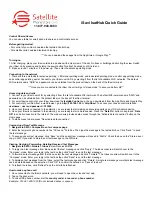
8 |
Operation |
HS70 User Manual
Operation
GPS Overview
For your convenience, both the GPS and SBAS operation of the HS70 features automatic
operational algorithms. When powered for the first time, the HS70 performs a “cold start,”
which involves acquiring the available GPS satellites in view and the SBAS differential service.
GPS Operation
The GPS receiver is always operating, regardless of the DGPS mode of operation. The following
sections describe the general operation of the HS70’s internal GPS receiver.
¼
Note:
Differential source and status have no impact on heading, pitch, or roll. They only have
an impact on positioning and heave.
Automatic Tracking
The HS70’s internal GPS receiver automatically searches for GPS satellites, acquires the signals,
and manages the navigation information required for positioning and tracking.
Receiver Performance
The HS70 works by finding four or more GPS satellites in the visible sky. It uses information
from the satellites to compute a position within 4.0 m. Since there is some error in the
GPS data calculations, the HS70 also tracks a differential correction. The HS70 uses these
corrections to improve its position accuracy to better than 1.0 m.
There are two main aspects of GPS receiver performance:
•
Satellite acquisition
•
Positioning and heading calculation
When the HS70 is properly positioned, the satellites transmit coded information to the
antennas on a specific frequency. This allows the receiver to calculate a range to each
satellite from both antennas. GPS is essentially a timing system. The ranges are calculated
by timing how long it takes for the signal to reach the GPS antenna. The GPS receiver uses a
complex algorithm incorporating satellite locations and ranges to each satellite to calculate
the geographic location and heading. Reception of any four or more GPS signals allows the
receiver to compute three-dimensional coordinates and a valid heading.
Differential Operation
The purpose of differential GPS (DGPS) is to remove the effects of atmospheric errors, timing
errors, and satellite orbit errors, while enhancing system integrity. Autonomous positioning
capabilities of the HS70 will result in positioning accuracies of 4.0 m 95% of the time. In order
to improve positioning quality to better than 1.0 m 95%, the HS70 is able to use differential
corrections received through the internal SBAS demodulator.
Automatic SBAS Tracking
The HS70 automatically scans and tracks SBAS signals without the need to tune the receiver.
The HS70 features two-channel tracking that provides an enhanced ability to maintain a lock
on an SBAS satellite when more than one satellite is in view. This redundant tracking approach
results in more consistent tracking of an SBAS signal in areas where signal blockage of a
satellite is possible.
HS70 Overview
The HS70 provides accurate and reliable heading and position information at high update
rates. To accomplish this task, the HS70 uses a high performance GPS receiver and two
antennas for GPS signal processing. One antenna is designated as the primary GPS antenna
and the other is the secondary GPS antenna. Positions computed by the HS70 are referenced
to the phase center of the primary GPS antenna. Heading data references the vector formed
from the primary GPS antenna phase center to the secondary GPS antenna phase center.
3
Summary of Contents for HS70
Page 1: ...ENGLISH HS70 User Manual www simrad yachting com...
Page 2: ......
Page 6: ...iv Contents HS70 User Manual...
Page 25: ......
Page 26: ...www bandg com www simrad yachting com www lowrance com 988 10147 001...












































